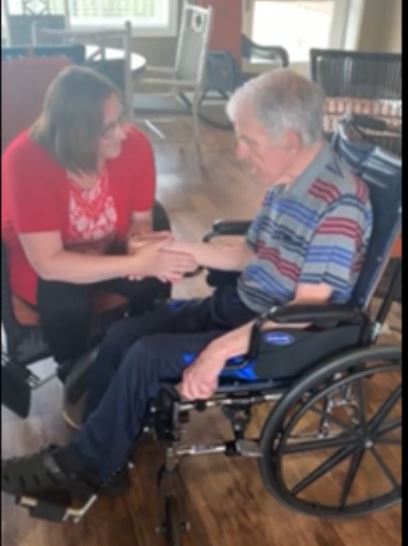Workforce Retention: Getting Back To The Basics
Posts by:



The workforce crisis in long-term care lingers as organizations desperately try to climb out from under the effects of the pandemic. The problem is so complex it feels too overwhelming to tackle, yet the current situation is not sustainable. The stress on administrators and the leadership team is taking a toll. Ensuring quality of care is simply impossible without a full complement of staff.
Human Resources professionals are working furiously to get people in and are gaining no ground due to turnover. The process of recruitment, hiring, and onboarding needs to be dramatically re-tooled to include intentional retention strategies.
The first hurdle is to create a new story about why someone should want to work in the aging services industry, and secondly, why long-term care?
The hard facts are important such as wages and benefits, work schedule, number of paid days off, etc. But there must be more to the picture. This industry has so much to offer that it should not be such a struggle to entice people to work for us.
Find ways to differentiate your community and make it easier for a recruit to say yes.
Gather insight from your leadership team and a sample of employees with this recruitment and retention temperature tool. An effective strategy can begin with first understanding your organization's strengths and areas for improvement.
About the author:
Julie joined the AGE-u-cate team in 2020 after working 31 years in nursing home operations. Starting in social services and admissions, she moved into management and executive positions in 1990 after obtaining an Illinois nursing home administrator license. Her passion for dementia capable care came early in her career when she had the good fortune to work with and learn from culture change pioneers. Julie is also an adjunct instructor in Gerontology and Aging Services at Northern Illinois University in DeKalb, IL. She lives in the Northwest Chicago Suburb of Schaumburg, Ill.

Searching for effective Quality Assurance/Performance Improvement (QAPI) Projects for Certified Nursing Communities is daunting. From finding the right project to looking for available resources can become challenging in our post-pandemic environment.
Fortunately, the Centers for Medicare and Medicaid (CMS) are legislatively mandated to provide funding to states for projects that improve the quality of life and the quality of care in certified nursing communities. The program is the Civil Monetary Penalty Grant Program (CMP).
The Civil Monetary Penalty Grant (CMP) program takes a portion of fines paid by nursing communities for regulatory infractions and funnels dollars back to states that accept applications to expend funds for projects that improve the quality of life and care for residents living in dually certified nursing communities. AGE-u-cate writes grant applications to states to bring our programs to dually certified communities at no cost to them.
Dually certified communities that decide to engage with AGE-u-cate on a grant project pay nothing because the funds are provided through the state directly to AGE-u-cate. This model allows the community to focus on performance improvement without the financial stress truly. Note: Every state implements CMP projects differently, so please check with us first.
Dually certified communities are required by federal regulation to engage in projects that measure and drive improvement in quality outcomes. It takes a lot of time to create an effective initiative from the ground up and keep all the balls juggling; this is where AGE-u-cate can assist. Our no-cost grant projects are organized as "QAPI in a box." We give communities all the tools needed to implement a project and measure the impact to staff and outcomes for the residents. You don't need to create the wheel because we've already done that work.
We will support the application process every step of the way and work with you to customize the project to fit your specific needs.
AGE-u-cate provides you with the resources to train, educate and build staff skills that will directly benefit your residents, which is a key component of any CMP project. All three AGE-u-cate programs have realized positive outcomes, and we provide you with support to sustain the program and collect outcomes.
Projects include online training for designated program coaches, onsite training for all staff delivered by an AGE-u-cate Certified Master Trainer, and subscriptions for our one-hour device-enabled microlearning staff training modules that reinforce the key components of each program and promote sustainability.
If your community needs a boost in Dementia Training, consider our program Dementia Live, a high-impact dementia simulation experience that immerses participants into life with dementia, resulting in a deeper understanding of what it’s like to live with cognitive impairment and sensory change.
If you need to equip your staff with a tool that reduces and even prevents resident stress reactions from residents in their care, consider Compassionate Touch, a caregiving approach that includes skilled touch and specialized communication shown to prevent stress reactions for people living with dementia and enhance the quality of life for those in later stages of life. Through this program, care partners also enjoy the benefits of reduced stress and increased job satisfaction associated with positive human connections.
Reading2Connect® is a resident-directed, Montessori-based program that provides staff training and specialized reading materials to engage residents of all abilities. The Reading2Connect® Program sparks residents’ imaginations, personal stories, laughter, an interest in learning, and much more. This program empowers residents, fostering enthusiastic participation, independence, and social connections.
Please don't hesitate to reach out and start the process. Our job is to make your job easier!
More information about accessing CMP funds

When we think of the word "home" it elicits more emotions and memories than any other word in the English language. Do we in Aging Services give enough consideration to the emotional impact that leaving home has on elders? Imagine leaving home and believing you will never return. Are we doing enough as caregivers to recognize and acknowledge the impact leaving home has on elders?
As we age, the need to relocate may occur several times. People may move from an established home of 40 years to a retirement community with desirable amenities or smaller quarters to reduce the burden of property upkeep. They may even move to be closer to family or a residential care facility. An important consideration for families and caregivers is the possible impact of relocation. What do we do to help?
Our natural responses could be: "It's OK, this is your new home" or "It just takes time to adjust." Many of us want to respond by giving advice, trying to cheer up our elderly family member, or changing the subject. We mean well, but these responses stifle communication and understanding things from another person’s viewpoint. No doubt, these are sincere efforts to comfort and reassure, but let's consider how we can take our compassion one step further by employing empathy.
Empathy is putting yourself in someone else's shoes in order to imagine what they are going through, understand, and even share their feelings.
According to Stanford University graduate Ted Talker Mike Robbins, empathy is one of the most critical aspects of creating solid relationships, reducing stress, and enhancing emotional awareness.
His 2021 blog provides the following benefits of empathy:
After acknowledging the feelings, you can then continue by validating, "It must be hard to miss your cat so much." Giving your care partner the time to express feelings and then validating those feelings is the most helpful approach you can offer because you cannot change anything about the reality of the situation.
Can empathy be taught? Absolutely! Would your staff benefit from a deeper understanding of empathy?
About the author:
Julie joined the AGE-u-cate team in 2020 after working 31 years in nursing home operations. Starting in social services and admissions, she moved into management and executive positions in 1990 after obtaining an Illinois nursing home administrator license. Her passion for dementia capable care came early in her career when she had the good fortune to work with and learn from culture change pioneers. Julie is also an adjunct instructor in Gerontology and Aging Services at Northern Illinois University in DeKalb, IL. She has two adult children and lives in the Northwest Chicago Suburb of Schaumburg with her husband and three fur babies. She is convinced that she was a lounge singer in a former life.

Dementia Competencies and How to Choose Good Education
Hosted by Joan Devine, the Pioneer Network presented an outstanding webinar entitled, "Dementia Competencies and How to Choose Good Education." The Dementia education universe is vast and varied, and it can be difficult to navigate to the most effective and relevant training.
The opening message offered by presenter Kim McRae, Founder of "Having a Good Life" and Co-Founder of the Culture Change Network of Georgia is that we should not use "Alzheimer's" as the general term for dementia. This causes a lot of confusion and marginalizes those living with dementia not related to Alzheimer's. As leaders, we need to be consistent in and steadfast in understanding this important distinction.
Jennifer Craft Morgan, Director and Associate Gerontology Professor at Georgia State University made a salient point that education and knowledge acquisition is important, but it must lead to skill-building. "Surface learning" alone will not change employees' care approaches.
Improving education and training and developing supports for direct care workers to implement skills in context has the potential to transform the workforce to a dementia-capable, culturally competent workforce. - Jennifer Craft Morgan.
Check out quality education programs provided by AGE-u-cate here:

So, if change is what we are after, then the first criteria to evaluate is whether the chosen curriculum will result in modifying employee care actions.
Kim McRae, Founder of "Have a Good Life" and Co-Founder of the Culture Change Network of Georgia cautioned listeners to avoid narrowly viewing people living with dementia from the standpoint of loss and deficits. In doing so, we create stigma, loss of well-being and excess disability. Training must un-do the "patients vs people" approach of the past and inspire the workforce to see the human being first.
The speakers then discussed language that should be used in training curriculum, because words absolutely matter.
"Living with dementia vs suffering with dementia"
"Responding to stress reactions vs managing unwanted behaviors"
Just as important as the content is the delivery. The presenters asked attendees to think back to their last training and identify the things that the instructor/training did that didn't support learning.
Helpful list of what not to do
Another critical point is that training should not be one-and-done. Learning must be consistent and ongoing, and reinforced by leadership. Leaders need to excite their employees! Talk with them about what they learned and how it can be applied to achieve person-centered care and improve the quality of life for elders.
In summary, training curriculum as offered by Ms. McRae and Dr. Morgan should:
Many thanks to the Pioneer Network and presenters for this critical and timely information.
About the author:
Julie joined the AGE-u-cate team in 2020 after working 31 years in nursing home operations. Starting in social services and admissions, she moved into management and executive positions in 1990 after obtaining an Illinois nursing home administrator license. Her passion for dementia capable care came early in her career where she had the good fortune to work with and learn from culture change pioneers. Julie is also an adjunct instructor in Gerontology and Aging Services at Northern Illinois University in DeKalb, IL. She has two adult children and lives in the Northwest Chicago Suburb of Schaumburg with husband and three fur-babies. She is convinced that she was a lounge singer in a former life.

I consider myself fortunate that so far, nobody in family has lived with dementia. Many people working in aging services are there after having personal experience caring for a loved one. Strangely enough, my first experience interacting with someone living with dementia was in college, during an internship in a CCRC my senior year.